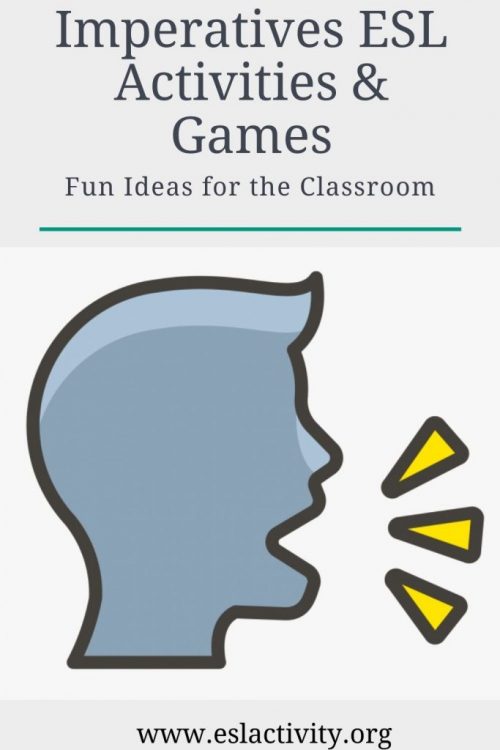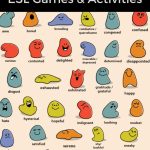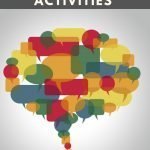If you’re looking for the best imperatives activities, games, exercises and all sorts of other good things, then you’re certainly in the right place. Keep on reading for everything you need to know about imperatives ESL.

Imperatives ESL activities
What is the Imperative?
An imperative is a command or order. It can also be used to give instructions, advice or a warning. Some examples include the following:
- Walk to the corner.
- Sit down please.
- Don’t lose your key.
The base form of the verb is used without a subject. However, the implied subject is “you.”
It can also be used to make a suggestion using “let’s.” For example:
- Let’s get sushi tonight.
- Let’s not do too much work this weekend.
Imperatives Activities and Games
Let’s get into the best imperative ESL activities to try out with your students.
#1: Simon Says
I’m sure you’ve played this popular game before! It’s a staple for any teacher of young learners and this game uses imperatives almost exclusively. Give it a try and let your students have a chance to give the commands as well. This pairs well with classroom objects or body parts vocabulary.
#2: Imperatives Concentration Game
This is a fun, but challenging memory game that’s ideal for kids as well as adults. Make up matching cards that have the following:
- Scenario (coach talking to tennis player)
- Imperative (hit the ball to her backhand)
Be sure to make sure that each one is quite unique and that there won’t be multiple cards that could potentially match. Then, in small groups, students essentially play a matching game as they try to match scenarios with imperatives. Have a look here:
https://eslactivity.org/concentration-an-esl-vocabulary-game/
#3: Imperative Sentence Song
When I teach kids, I love to include songs and chants into my classes. They’re a fun way for students to get a ton of practice with a specific grammar point or vocabulary set. Sometimes I even catch my students singing the song to themselves in between classes and then I know I’ve done my job well! Have a look on YouTube and you’ll be able to easily find one that’ll work for you and your students.
#4: Dictogloss
If you teach more advanced students, try out this challenging listening activity. Find (or write) a passage with someone giving lots of commands. It could be a parent talking to their child about getting ready for a trip. Or, a teacher talking to their students. Or, a boss to their employee about an upcoming work project. Of course, include a lot of examples of the imperative.
Then, put students into pairs and read it out at a faster than normal pace for the level of the students. The students have to work together to try to recreate what they heard. Then, repeat the process again. Finally, students compare what they have with the original version.
Sounds like something you want to try out? Find out all the details about one of my favourite imperative exercises here:
https://eslactivity.org/dictogloss-esl-listening-and-speaking-activity/
#5: Flyswatter Imperative Game
This is a fun game that can inject a bit of excitement into the classroom. Write a bunch of imperative statements randomly on the whiteboard such as:
- Sit down
- Be quiet
- Put your shoes on
- Go to sleep
- Brush your teeth
- Don’t be late
- Run faster
- Don’t take a penalty
Then, divide the class into two teams. One student from each teams comes up to the front of the class and takes a flyswatter. Then, give a scenario. For example, a coach talking to his hockey team. The first person to slap, “Don’t take a penalty” would get a point. Erase that imperative and put another one in the same place.
Try out with this fun game today! More details about it:
https://eslactivity.org/flyswatter-esl-vocabulary-game-for-kids/

Imperatives exercises
#6: Error Correction Relay Race
If you want to focus on forms, then try out this error correction relay. It takes something old (error correction) and makes it fun by turning it into a relay game. In this case, make a number of errors on the worksheet related to imperatives. Try it out:
https://eslactivity.org/error-correction-relay-race/
#7: Imperatives on Popular TV Shows
I love to show my students examples of grammar points in real life and TV or movies is one of the best ways to do that. Here’s an excellent video to consider showing your students:
https://www.youtube.com/watch?v=gl4r574QTnw
#8: Word Association
Unless you teach absolute beginners, it’s likely that students are already at least a little bit familiar with the imperative. If this is the case, use Word Association to help students activate their prior knowledge.
Think of a number of scenarios where people might use imperatives. For example:
- A teacher explaining an assignment
- A boss reprimanding an employee
- A parent talking to their child
- Etc.
Then, have students brainstorm some commands, advice, etc. that they might here in those situations. Want to find out more? Have a look:
https://eslactivity.org/word-association-an-esl-vocabulary-activity/
#9: How Can I Get to the ______?
A simple way for students to practice imperatives is to ask a partner how they can get to a certain place at the school or on campus. The other students has to give commands using the imperative. For example:
- Go out of the classroom.
- Turn left and walk to the end of the hall.
- Take the elevator to the first floor.
- Etc.
#10: Is that Sentence Correct?
If you want to focus on forms of imperatives, consider using this simple error correction activity. Write a bunch of sentences that use the imperative but make some mistakes in them. If you want to make it a bit more difficult, include some sentences with no mistakes in them. Students have to work together to find the mistakes and correct them.
This activity is ideal for an in-class activity or consider assigning it for homework. Check it out:
https://eslactivity.org/english-grammar-activity-is-that-sentence-correct/
#11: Ball Toss Imperative Game
This is a quick way to bring some energy into the classroom! Write down some scenarios on a beach ball with a marker. For example:
- Teacher to students
- Dad to child
- Coach to player
- Boss to employee
Then, students have to toss the ball around the classroom and give an imperative for whatever scenario their right thumb lands on. My rule is that students can’t repeat any previous imperative. Try it out today:
https://eslactivity.org/ball-toss-4-skills-esl-activity/
#12: Running Dictation
#13: ESL Imperative Dictation Practice
Dictation has kind of fallen out of favour with the more communicative approach to language teaching. However, it’s still a useful exercise and is ideal for working on the forms of a specific grammar point, as well as spelling and punctuation. Find out more:
https://eslactivity.org/dictation-practice-esl-writing-and-listening-activity/
#14: Imperative Charades
Write down a bunch of imperatives on pieces of paper and then play charades. It’s a fun way to review this grammar point and have a bit of fun at the same time.
Then, divide the class up into 2 or 3 teams. The first team sends a student to the front who has to act out what they see on the paper while their team guesses what they’re doing. They can try to get as many points as possible in one minute. Each team can have a chance to play a few rounds. I allow each team to have one “pass” per round if they don’t know a certain vocabulary word.
#15: Picture Prompt
Find a picture where someone (student or child) is doing a lot of bad things! For example, a child with a very messy bedroom. Or, a student who is on their cellphone in class, with their feet on the desk eating snacks. Then, students have to issue some imperatives to that person to get their act together!
#16: Instructional Videos
Show short videos that demonstrate how to do various tasks or activities. Pause the video at certain points and ask students to provide imperative instructions based on what they see. For instance, if the video is about cooking, pause and ask, “What should we do next?” Students can respond with imperatives like “Stir the ingredients” or “Preheat the oven.”
#17: Role Plays
Divide students into pairs or small groups and assign them different scenarios. Each group member takes turns giving instructions to their partner(s) using imperatives. For example, one student might pretend to be a teacher giving instructions to a student, such as “Open your book to page 10” or “Write your name on the top of the paper.”
#18: Flashcard Action Game
Create a set of flashcards with different actions or verbs written on them (e.g., jump, run, eat). Place the flashcards face down on a table or board. Students take turns picking a card and giving an imperative command related to the action on the card. The rest of the class must perform the action. For example, if a student picks the card with “jump,” they can say “Jump three times!”
#19: Picture Sequencing
Provide students with a series of pictures that depict a sequence of events. Students work individually or in pairs to arrange the pictures in the correct order. Once the order is determined, students describe the actions in the pictures using imperatives. This activity helps reinforce sequencing and using imperatives to describe steps or instructions.
#20: Imperative Chain
Begin with a simple imperative sentence, such as “Stand up.” The next student adds another imperative instruction, building on the previous one. For example, “Stand up, turn around.” Continue the chain, with each student adding a new imperative instruction while repeating the previous ones. This activity encourages creativity and memory recall of previous imperatives.

Best ways to practice the imperatives ESL
#21: Imperative Board Game
Design a board game where students move their game pieces by following imperative commands. Each space on the board should have a written imperative command. When a student lands on a space, they must say the imperative aloud and then perform the action. For example, if the space says, “Brush your teeth,” the student says the command and pretends to brush their teeth. The first student to reach the finish line wins the game.
Imperatives ESL FAQs
There are a number of common questions that people have about using this kind of English grammar. Here are the answers to some of the most common ones.
What is an imperative for ESL?
An imperative can be used to give a command or order. For ESL students who are learning English grammar, it’s the base form of the verb and it’s often used without a subject. For example, “Go!”
How do you teach imperatives to ESL?
To teach imperatives to ESL, follow a normal lesson plan style. For example:
- Warm-up.
- Introduce imperatives/set the context.
- Controlled practice.
- Freer practice.
- An activity to reinforce concepts.
- Review.
- Homework (optional).
What are imperatives in English?
In English, the imperative mood is used to give orders, prompt something to do something, warn someone or give instructions. You can use an affirmative, negative or exhortative imperative, depending on the situation. An imperative consists of the base form of the verb.
What are imperatives examples?
Here are some imperatives examples:
- Sit down.
- Eat your lunch.
- Don’t run.
- Go faster.
How do imperatives differ from other sentence types?
Imperatives do not have a subject pronoun (such as “you”) explicitly stated. They are direct commands or requests. For example, “Study for the test” instead of “You should study for the test.”
Can we use imperatives to give advice?
Yes, imperatives can be used to give advice or suggestions. For example, “Exercise regularly” or “Try this new restaurant.”
Is it necessary to use the word “please” in every imperative sentence?
No, it is not necessary to use “please” in every imperative sentence, but it can make the request more polite and considerate.
How can we make negative imperatives?
Negative imperatives are formed by adding “don’t” before the base form of the verb. For example, “Don’t forget your umbrella” or “Don’t touch the hot stove.”
What are some examples of imperatives for daily routines?
Examples of imperatives for daily routines include “Wake up early,” “Brush your teeth,” “Take a shower,” “Eat breakfast,” and “Go to bed on time.”
Online Practice for Imperatives
There are a number of ways for students to get practice with imperatives. Of course, in-class is a nice way to do that, as well as homework assignments. There are also a number of great resources for imperatives exercises online. Here are some of the best options:
Imperative Worksheets
A nice way to save a ton of time is to use some ESL imperatives worksheets for an in-class assignment or for homework. Here are some of our top picks for imperatives exercises:
Imperatives ESL Lesson Plans
If you’re a teacher then you’ll know how much time you can save by using a lesson plan that’s already made. Here are some of our top picks for imperative lesson plans to consider using with your students:
Did you like these Imperative Activities?
- Amazon Kindle Edition
- Bolen, Jackie (Author)
- English (Publication Language)
- 112 Pages - 10/24/2019 (Publication Date)
Yes? Thought so. Then you’re going to love this book over on Amazon: 39 No-Prep/Low-Prep ESL Grammar Activities and Games. The key to better TEFL classes is a wide variety of interesting, engaging activities and this book will help you get there in style.
Pick up the digital copy of the book to take with you to your favourite coffee shop for some lesson planning on the go. Or, consider keeping a copy on the bookshelf in your office to use as a handy reference guide. Whatever the case, get ready for some ESL teaching awesome in your life.
Head over to Amazon to pick up your copy of the book today:
List of the Most Common Imperatives in English
Here’s a list of some of the most common imperatives used in English:
- Open the door.
- Close the window.
- Turn on the lights.
- Sit down.
- Stand up.
- Be quiet.
- Pay attention.
- Listen carefully.
- Read the book.
- Write your name.
- Take a seat.
- Wait here.
- Come here.
- Go there.
- Speak louder.
- Study for the test.
- Do your homework.
- Clean your room.
- Wash your hands.
- Eat your vegetables.
- Drink plenty of water.
- Sleep well.
- Take a break.
- Put on your coat.
- Take off your shoes.
- Don’t talk in class.
- Don’t touch that.
- Don’t run.
- Don’t forget your keys.
- Don’t be late.
Have your say about Imperatives ESL
What’s your top pick for a way to practice the imperative for English learners? Is it one of the options from this list or do you have your eye on another one? Leave a comment below and let us know what you think. We’d love to hear from you.
Also be sure to give this article a share on Facebook, Pinterest, or Twitter. It’ll help other busy Engish teachers, like yourself find this useful resource.
Last update on 2022-07-17 / Affiliate links / Images from Amazon Product Advertising API





